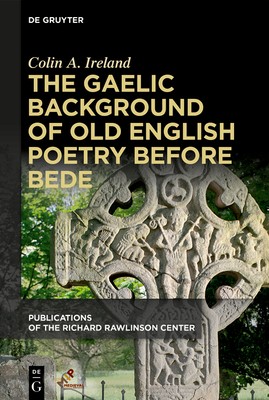
- We will send in 10–14 business days.
- Author: Colin A Ireland
- Publisher: Medieval Institute Publications
- ISBN-10: 1501522140
- ISBN-13: 9781501522147
- Format: 15.6 x 23.4 x 2.6 cm, minkšti viršeliai
- Language: English
- SAVE -10% with code: EXTRA
The Gaelic Background of Old English Poetry Before Bede (e-book) (used book) | bookbook.eu
Reviews
Description
Seventh-century Gaelic law-tracts delineate professional poets (filid) who earned high social status through formal training. These poets cooperated with the Church to create an innovative bilingual intellectual culture in Old Gaelic and Latin. Bede described Anglo-Saxon students who availed themselves of free education in Ireland at this culturally dynamic time. Gaelic scholars called sapientes ("wise ones") produced texts in Old Gaelic and Latin that demonstrate how Anglo-Saxon students were influenced by contact with Gaelic ecclesiastical and secular scholarship. Seventh-century Northumbria was ruled for over 50 years by Gaelic-speaking kings who could access Gaelic traditions. Gaelic literary traditions provide the closest analogues for Bede's description of Cædmon's production of Old English poetry. This ground-breaking study displays the transformations created by the growth of vernacular literatures and bilingual intellectual cultures. Gaelic missionaries and educational opportunities helped shape the Northumbrian "Golden Age", its manuscripts, hagiography, and writings of Aldhelm and Bede.
EXTRA 10 % discount with code: EXTRA
The promotion ends in 21d.18:35:16
The discount code is valid when purchasing from 10 €. Discounts do not stack.
- Author: Colin A Ireland
- Publisher: Medieval Institute Publications
- ISBN-10: 1501522140
- ISBN-13: 9781501522147
- Format: 15.6 x 23.4 x 2.6 cm, minkšti viršeliai
- Language: English English
Seventh-century Gaelic law-tracts delineate professional poets (filid) who earned high social status through formal training. These poets cooperated with the Church to create an innovative bilingual intellectual culture in Old Gaelic and Latin. Bede described Anglo-Saxon students who availed themselves of free education in Ireland at this culturally dynamic time. Gaelic scholars called sapientes ("wise ones") produced texts in Old Gaelic and Latin that demonstrate how Anglo-Saxon students were influenced by contact with Gaelic ecclesiastical and secular scholarship. Seventh-century Northumbria was ruled for over 50 years by Gaelic-speaking kings who could access Gaelic traditions. Gaelic literary traditions provide the closest analogues for Bede's description of Cædmon's production of Old English poetry. This ground-breaking study displays the transformations created by the growth of vernacular literatures and bilingual intellectual cultures. Gaelic missionaries and educational opportunities helped shape the Northumbrian "Golden Age", its manuscripts, hagiography, and writings of Aldhelm and Bede.


Reviews